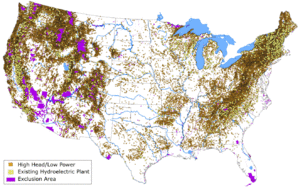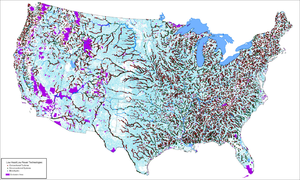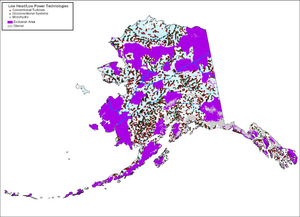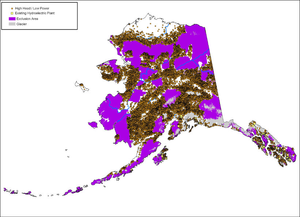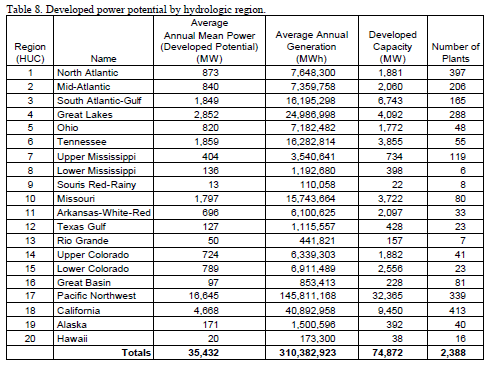United States of America Energy Situation
Overview
The United States of America | |||
| |
| ||
|
Capital |
Washington D.C 38°53'N 77°01'W | ||
|
Official language(s) |
None at federal level [a] | ||
|
Government |
Federal presidential constitutional republic | ||
|
President |
Barack Obama | ||
|
Total area |
9,826,675 km2[1] | ||
|
Population |
313,206,000 (2012)[2] | ||
|
Rural population |
55,700,625 (2011)[3] | ||
|
GDP (nominal) |
$15.065 trillion (2011)[4] | ||
|
GDP Per capita |
$48,147 (2011)[5] | ||
|
Currency |
United States Dollar $ USD | ||
|
Time zone |
(UTC- 5 to -10) Summer (DST) (UTC - 4 to -10) | ||
|
Electricity generation |
4,253.3 TWh/year (2009)[6] | ||
| Access to Electricity | ~100% | ||
|
Wind energy (installed capacity) |
43,635 MW (2011) [7] | ||
|
Solar Energy (installed capacity) |
3,954 MW (2011)[8] | ||
Energy situation
Energy in the United States of America are produced from a variety of sources. The primary source of energy in the United States is coal at .
Renewable energy sources
Hydropower
|
|
Existing hydroelectric plants and high head/low power water energy sites in the conterminous United States.[9]
|
|
Low head/low power water energy sites in the conterminous United States[10] |
| Low-head-low power water energy sites in Alaska | |
| Existing hydroelectric plants and high head-low power water energy sites in Alaska |
| https://energypedia.info/extensions/WYSIWYG/ckeditor/skins/isck/images/noimage.png?t=B49E5BQ |
Distribution of the low head...... |
| https://energypedia.info/extensions/WYSIWYG/ckeditor/skins/isck/images/noimage.png?t=B49E5BQ |
power category......... |
| https://energypedia.info/extensions/WYSIWYG/ckeditor/skins/isck/images/noimage.png?t=B49E5BQ |
power class.......... |
| Summary of results of water energy recourse assesment of the United States | |
|
Total capacity of hydroelectric plants in the united states by >sizes< | |
|
total number of hydroelectric plants in the united states |
Solar power
Biomass
Wind power
Geothermal Power
Policy framework, laws and regulations
Institutional set up in the energy sector
Activities of other donors
References:
- ↑ "United States". The World Factbook. CIA. 2009-09-30. Retrieved 2010-01-05 (area given in square kilometers).
- ↑ U.S. POPClock Projection". U.S. Census Bureau. Figure updated automatically.
- ↑ http://www.tradingeconomics.com/united-states/rural-population-percent-of-total-population-wb-data.html
- ↑ United States". International Monetary Fund. Retrieved 2011-10-09.
- ↑ United States". International Monetary Fund. Retrieved 2011-10-09.
- ↑ http://www.energy.eu/stats/energy-electricity-production.html
- ↑ http://www.windpoweringamerica.gov/wind_installed_capacity.asp
- ↑ http://www.seia.org/galleries/pdf/SMI-YIR-2011-ES.pdf
- ↑ http://hydropower.inel.gov/resourceassessment/pdfs/03-11111.pdf (pg. 47)
- ↑ http://hydropower.inel.gov/resourceassessment/pdfs/03-11111.pdf (pg. 29)

